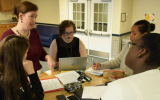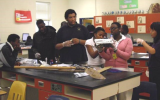Student Retention

Like most community colleges across the United States, the Maricopa Community Colleges (MCCCD), a 10-college district in the Phoenix metro area, has been challenged by high attrition and low completion rates. In fact, the National Student Clearinghouse Research Center (2024) shared that while community colleges are starting to see slight increases in retention and completion, most continue to lose more than 45 percent of students after one year, and even more after the second year.
After decades of retention rates hovering around 50 percent and completion rates in the teens, in 2019, Maricopa...
In 2014, Dalton and Crosby noted that, “colleges and universities have long recognized that helping students to become personally connected and committed early in college is critical to their successful retention and graduation” (Abstract). However, feeling connected to an institution and its academic process can be “especially challenging for new students who must quickly master a wide range of academic, personal, and social adjustments” (Dalton & Crosby, 2014, Abstract).
In a mission to retain students and guide them toward success, Rio Salado College, an online community college based...
Tags:

When St. Louis resident Bobbie Simmons enrolled at St. Louis Community College (STLCC) to study medical coding, it seemed like she was finally on the path to a rewarding career in a high-demand field. Then a serious health issue set her back, threatening her ability to maintain a dependable source of income for rent. “It was hard focusing on my schoolwork when I didn’t know if I’d have a roof over my head,” said Simmons. Her story is not unique; many students at STLCC face similar challenges.
Thanks to a new STLCC program, students like Simmons, who face housing insecurity, now have a...
Tags:

Jackson College has been committed to providing excellent education and support to its students for over 95 years. In today's fast-paced world, college students' requirements and needs are evolving. To address these needs, Jackson College has initiated a pilot program called Harriet's Hub, which serves as a one-stop student resource center.
The name hearkens back to the college’s heritage, remembering a former faculty member, Harriet Myer, who helped college students by establishing a student assistance fund. With two rooms of dedicated space in the college’s library, the hub provides...
Tags:

Postsecondary institutions have long recognized the importance of student success and retention, with many colleges and universities explicitly emphasizing these goals in their strategic plans (Darabi & Garland, 2018). Throughout the United States, campus learning centers, which the National College Learning Center Association defines as “interactive academic spaces which exist to reinforce and extend student learning in physical and/or virtual environments” (as cited in Darabi & Garland, 2018, p. 4), regularly contribute to success and retention efforts. Delta College, which serves...
Tags:

Student retention continues to be a major concern for most community colleges in the U.S. According to research conducted by the National Student Clearinghouse Research Center (2019), of all students enrolled in two-year public institutions beginning in fall 2017, only 48.9 percent would continue at the same institution in fall 2018. Comparatively, students at four-year public institutions over the same period boasted an 82.7 percent retention rate. While students may struggle for a variety of reasons, one way to positively address this issue is within the classroom. Over the course of an...

Almost half of U.S. community college students responding to the #RealCollege survey conducted by The Hope Center for College, Community and Justice indicated that they had experienced food insecurity within the 30 days before completing the survey (Goldrick-Rab et al., 2019). In response, an increasing number of community colleges are working to eliminate food insecurity for students and their families. Through programs such as on-campus food pantries, community gardens, farmers’ markets, and food scholarships, colleges are finding solutions for students and, in some cases, staff who are...

Research suggests that student success, or first-year experience, classes are beneficial to new college students. A 2013 study by the Community College Research Center showed initial gains in credits earned and first-year retention (Karp and Stacey, 2013), although the same report found mixed results for long-term gains. Klinkenberg (2013) found higher rates of academic progress and persistence for students who completed a first-year experience course compared with those who did not enroll or did not successfully complete the course. A study at a Tennessee community college found higher fall-...

In October 2012, Austin Community College District (ACC) was awarded a four-year, $2.1 million TAACCCT grant from the U.S. Department of Labor to assist students with the removal of barriers to degree completion and acquisition of entry-level positions in the field of information technology (IT). With grant funds, the college designed a new online competency-based education (CBE) program—Accelerated Programmer Training (APT). The initiative improved distance learning curriculum and delivery, which, in turn, increased student enrollment and graduation rates, and, ultimately, amplified job...

Like most community colleges across the U.S., Kirkwood Community College embodies the widely celebrated educational ideal that it’s never too late to get a college education. This ideal is on display every day at 10 campuses spread out over the college’s seven-county service area in eastern Iowa. In fact, the age range for enrolled, degree-seeking students at the college is from 16 to 74 years old, and that range grows even wider when dual enrollment numbers are considered.
When Kirkwood first opened its doors in 1966, the educational delivery format was the same for every student, no matter...

Those at Moraine Valley Community College (MVCC) in Palos Hills, Illinois, believe that the measure of student success is best determined by the students themselves. With that in mind, the college’s Completion Commitment Committee implemented several initiatives, including a Retention Academy, to help students reach their goals.
Student success can be completion of a degree, but it can also be completing a class or achieving a passing grade. “Of course, when we talk about completion, we want students to earn a degree, but that’s not the only way they are successful,” said Dr. Margaret Lehner...

As much as the faculty, classified professionals, and administration at San Diego City College take pride in the 1,500 classes and 200+ degree and certificate programs offered at the 60-acre urban campus, they also understand that the college’s role in supporting and empowering students goes far beyond the classroom. For instance, thirty-nine percent of college students experience significant mental health issues, yet two-thirds with anxiety or depression do not seek treatment (Active Minds, n.d.). Even more alarming is the fact that suicide is the second leading cause of death among college...
Tags:

It’s crunch time on campus at Onondaga Community College (OCC). Spring semester final exams are just over a week away. In Professor Kristen Costello’s Microeconomics (ECO 204) class she’s discussing final project options with students. “You can do either a paper or a presentation,” Costello said. “If you choose a presentation you can do so as an individual or in a group of up to three people.”
Costello is holding class in the lounge of one of the college’s four residence halls. This particular residence hall is the home of Business majors who reside in one of the college’s Living Learning...

To address the representation gap in the sciences, a partnership of institutions implemented two different early college/dual enrollment courses for high school students as part of a larger project. One program was a concurrent (in-school) enrollment program, and the other was a summer residential program. Each program ran for five years, and all of them successfully prepared students for college STEM. Many students entered STEM programs in college, and 80 percent of them are still there today.
The Larger Project
The Minority Student Pipeline Math and Science Partnership—(MSP)2—was a joint...

A number of promising interventions have potential to benefit previously incarcerated young men of color (Wimer & Bloom, 2014). Several studies have shown that proactive programs that help young men of color connect to and progress through postsecondary education and training, as well as interventions that focus on emotional well-being and interpersonal problem-solving, lead to lower rates of recidivism, higher completion rates, and greater levels of employment (Patel & Valenzuela, 2013; Scrivener & Weiss, 2013; Heller, Pollack, Ander, & Ludwig, 2013).
Thus, in conceptualizing...
Tags:

American College Testing, with over fifty years of college readiness research, defines college readiness as students having “a 50% chance of obtaining a B or higher or about a 75% chance of obtaining a C or higher in the corresponding credit-bearing college courses, which include English Composition, Algebra, Social Science and Biology” (ACT, 2012, p. 3). Unfortunately, the majority of students graduating from high school are not college ready, and the need for improvement in the American high school educational structure is clear. Test results from 2015 give the percentage of high school...
August
2015
Many Norwalk Community College (NCC) students work full-time and care for their families while attending college. It's a constant juggling act with hurdles to overcome, including taking care of sick children, squeezing in study time between doctor's appointments, and coping with rising food costs.
NCC realizes that having determination and a sterling work ethic aren't enough for some students to succeed. That's why, in addition to the requisite financial aid and career services, NCC offers two uncommon support services that provide students with free medical care and free groceries, right on...
Tags:
July
2015
Every college campus has a feel, an atmosphere, that is all its own. Having spent the last 16 years working in metropolitan community colleges, I have had the opportunity to see all types of students interact with one another in that atmosphere, as well as with faculty and staff from all backgrounds. All students are on campus to learn, and when the learning mission is disrupted, it's important to know two things: why it was interrupted and how the college can stop the interference from reoccurring. One issue facing today's college campuses is how to comply with federal Title IX guidelines....
June
2015
Minnesota State Community and Technical College (M State) has announced an ambitious and exciting initiative that uses the Collegiate Learning Assessment (CLA+) as a tool to identify student achievement. CLA+ is a performance-based assessment that measures critical thinking, complex reasoning, and written communication and mechanics.
Up2U
Up2U is an incentive-based program that supports student learning, increases persistence and motivation, and advances achievement in degree completion. Students who participate in Up2U are driven to finish school on time and with a high level of academic...
Tags:










